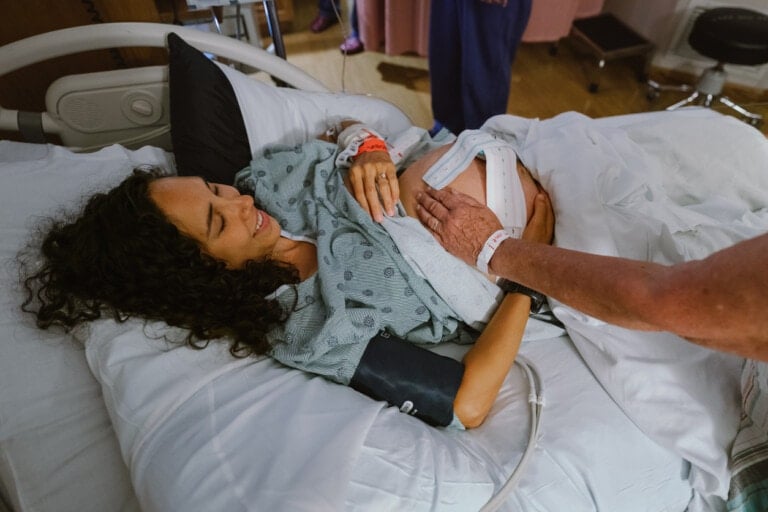Most parents look forward to the miracle of childbirth, but what happens when the journey takes a dangerous turn? Enter shoulder dystocia, a complication that can turn the birthing process into a terrifying ordeal for everyone. Shoulder dystocia is a medical emergency that occurs when your baby’s head delivers, and one or both of her shoulders get stuck behind your pelvic bone. It is a rare but severe condition that can cause long-term consequences for you and your baby.4
Let’s explore shoulder dystocia in more detail, including what it is, why it happens, how common it is, and what to do if it happens.
What Is Shoulder Dystocia?
Shoulder dystocia is a complication of childbirth that occurs in approximately 1 in 150 vaginal deliveries, or 0.7% vaginal births. The condition happens when your baby’s shoulder becomes impacted behind your pubic bone during delivery, which prevents the baby’s body from being delivered. It is considered an obstetric emergency because it can lead to a prolonged and difficult delivery that can cause complications for both the baby and the mother.1
Why Does Shoulder Dystocia Happen?
Shoulder dystocia can happen for various reasons. Risk factors include:1,2,4
- Fetal macrosomia (a large baby)
- Obesity in the mother
- Excessive weight gain during pregnancy
- Diabetes
- Long labor
- Prolonged pushing stage of labor
- Previous history of shoulder dystocia
- Use of forceps or vacuum to deliver the baby
- Induced labor
- Baby is in the wrong position
- Mother has a small or abnormally shaped pelvis
- Mom is older than 35
- Delivery after the due date
- Having an epidural
Even though there are risk factors for shoulder dystocia, it usually happens unexpectedly. Because it is difficult to predict, it is also difficult to prevent.2
One of the risk factors for shoulder dystocia is having a large baby. Estimating fetal weight is difficult and inaccurate. Induction of labor does not prevent shoulder dystocia. Your provider will recommend a Cesarean delivery to avoid shoulder dystocia if your baby’s estimated weight is 11 pounds and you don’t have diabetes. If you have diabetes, your doctor will recommend Cesarean birth if your baby is estimated to be 9 pounds, 15 ounces, or larger.2
Complications of Shoulder Dystocia for the Mother
Many risk factors can lead to shoulder dystocia, but it can happen to anyone. There aren’t any symptoms. Your doctor or midwife will notice the condition when it occurs. Often the first sign is when your baby’s head delivers but then pulls back in. When this happens, it’s called the “turtle sign.”4
Shoulder dystocia can lead to serious complications for both you and your baby. For mothers, the difficulties include:2,3,4
- Postpartum hemorrhage: Excessive bleeding can occur after delivery, which can be life-threatening. Postpartum hemorrhage is the most common complication for the mother.
- Lacerations: If shoulder dystocia occurs, you are more likely to have large tears in your vagina, rectum, or urethra.
- Nerve compression: Compression of specific nerves can cause numbness, tingling, or burning pain in your outer thigh.
- Separation of pubic bones: Two bones form the pubic bone with cartilage in between. These can become separated, leading to pain and difficulty walking.
- Uterine rupture: This occurs when the wall of your uterus tears open.
- Rectovaginal fistula: This is an abnormal connection between your rectum and vagina.
- Psychological stress: When your baby’s shoulder gets stuck, it is frightening and often traumatic.
Complications of Shoulder Dystocia for the Baby
Complications for the baby from shoulder dystocia include:2,3,4
- Brachial plexus injury: This is an injury to the nerves in the baby’s neck and shoulder that can cause weakness or paralysis of the arm. The weakness or paralysis usually resolves but can be permanent. Such injury is the most common complication for your baby.
- Compressed umbilical cord: Your baby’s umbilical cord can get pinched between the arm and pelvic bone. When this happens, your baby’s oxygen and blood flow are cut off.
- Fractured collarbone: The baby’s collarbone can break during delivery, causing pain and discomfort. These fractures usually heal without complications.
- Fractured upper arm: Baby’s upper arm can break when delivering it. These fractures usually heal well.
- Hypoxic-ischemic encephalopathy: This is a rare but severe condition where the baby’s brain is deprived of oxygen, which can result in brain damage and other long-term complications.
- Death: In rare cases, babies won’t survive shoulder dystocia. This risk is very low at 0.4% of cases.
All these possible complications can be terrifying. Remember, however, most babies that get stuck during delivery are born safely.4
What to Do When Shoulder Dystocia Happens
If your provider suspects shoulder dystocia during delivery, they will act quickly to reduce the risk of complications. The longer the shoulder is stuck, the higher the chance of complications for your baby. Usually, your nurse pulls an emergency alarm, and your room fills with extra staff to assist with the emergency. The alarms and rush of extra people can be very scary. Your provider will have little time to explain what is happening.3
Your baby’s shoulder needs to be delivered as quickly as possible so he can be born and start breathing. Doctors and midwives are trained in skills to help promptly release your baby’s shoulder. Your provider will ask you to stop pushing as they carry out different maneuvers. Following are some of the most common maneuvers they might perform:1,2
- McRoberts maneuver: Involves laying flat and raising your legs to your chest to widen the pelvic outlet, which can help release your baby’s shoulders. This is almost always the first action taken if shoulder dystocia happens.
- Suprapubic pressure: Applying pressure to your abdomen just above the pubic bone to move the baby’s shoulders.
- Rubin maneuver: Rotating the baby’s shoulders to facilitate delivery.
- Woods corkscrew maneuver: Rotating the baby’s body to release the shoulders.
- Posterior arm: Your provider puts a hand in your vagina and delivers one of your baby’s arms. Then, the shoulder can pass through.
- Hands and knees: Midwives sometimes have you get on hands and knees when shoulder dystocia occurs. This position makes the pelvis wider and helps release the shoulder.
- Episiotomy: An episiotomy creates a larger vaginal opening allowing more room for your provider to perform the necessary maneuvers to deliver your baby.
If shoulder dystocia occurs, follow your doctor’s or midwife’s directions. Staying calm and following their instructions is the best thing you can do for yourself and your baby. After your baby is born, a pediatrician will examine your baby, and your provider can discuss with you what happened.
Prevention of Shoulder Dystocia
Although it is not always possible to prevent shoulder dystocia, there are specific measures you can take to reduce the risk, including:1,4
- Maintain a healthy weight during pregnancy.
- Monitor fetal growth during pregnancy.
- Manage diabetes.
- Avoid vacuum or forceps-assisted delivery when possible.
- Be aware of the risk factors for shoulder dystocia.
- Consider not having an epidural in labor.
Shoulder dystocia is a medical emergency that is very stressful for everyone, including you, your partner and family, the nurses, and your doctor or midwife. The best thing everyone can do during shoulder dystocia is to remain calm and do exactly what the doctor or midwife instructs. Remember, most babies are delivered healthy even when the shoulders get stuck.
Shoulder dystocia is a rare but severe complication of childbirth that can cause long-term consequences for both the mother and her baby. It is often unpreventable. Doctors and midwives act quickly to reduce the risk of complications if shoulder dystocia happens during delivery. Discuss your risk factors for shoulder dystocia with your healthcare provider.






























